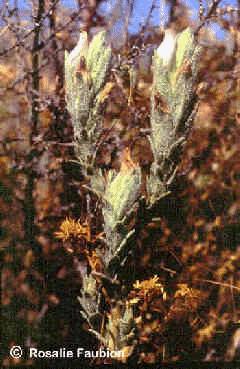Endangered Species Recovery Program | |
|
Home | News | Publications | Species profiles | Data and maps | About | Staff | Links | Department of Biological Sciences | CSU Stanislaus |

Palmate-bracted bird's-beak
Cordylanthus palmatus
Status
U.S.A. and California Endangered
Life History
Palmate-bracted bird's-beak is an annual plant belonging to the snapdragon family. The plant is highly branched and is covered with short glandular hairs that excrete salt crystals, giving mature plants a grayish-green appearance. In all Cordylanthus species, the corolla (the set of petals) is club-shaped and is divided lengthwise into two lips (groups of fused petals that differ in appearance). The upper lip is hooked like a bird's beak and the lower lip is inflated like a pouch. The flowers are nearly hidden by bracts, which are leaf-like structures. The outer bracts are green; the inner bracts are lavender and deeply divided into finger-like segments (i.e. palmate). The corolla is hairy, whitish to lavender on the sides, and has fine purple stripes on the lower lip. The seeds have distinctive arching crests.
Cordylanthus species are hemiparasitic, meaning that they manufacture their own food but obtain water and nutrients from the roots of other (host) plants. The host plant for palmate-bracted bird's-beak is believed to be saltgrass (Distichlis spicata). The combination of hemiparasitism, salt excretion, and a deep root system allows palmate-bracted bird's-beak to grow during the hot, dry months after most other annuals have died. This species flowers from May until October. Bumblebees are the primary pollinators of palmate-bracted bird's-beak, and both self- and cross-pollination can contribute to seed-set. Individual plants can produce up to 1,000 seeds in a single growing season, which form a persistent seedbank. The number of plants in a population varies annually in response to environmental conditions, particularly precipitation.
This species is restricted to seasonally-flooded, saline-alkali soils in lowland plains and basins at elevations of less than 155 m (509 ft). Within these areas, palmate-bracted bird's-beak grows primarily along the edges of channels and drainages, with a few individuals scattered in seasonally-wet depressions, alkali scalds (barren areas with a surface crust of salts), and grassy areas. Palmate-bracted bird's-beak occurs in the Valley Sink Scrub and Alkali Meadow natural communities in association with other halophytes (plants which grow in alkaline or salty soils), such as iodine bush (Allenrolfea occidentalis), alkali heath (Frankenia salina), glasswort (Salicornia subterminalis), seepweed (Suaeda moquinii), and saltgrass. Suitability of microhabitats for palmate-bracted bird's beak depends primarily on soil pH and to a lesser extent on soil layering, salinity, and moisture. Under natural conditions, this species occurs on neutral to alkaline soils.
Distribution
Between 1916 and 1982, nine natural populations of palmate-bracted bird's-beak were documented, but as of 1985 only two were known to be extant. The historical occurrences were in Alameda, Fresno, Madera, San Joaquin, and Yolo counties.
Palmate-bracted bird's-beak is now known to occur in seven metapopulations (defined as scattered groups of plants that may function as a single population due to occasional interbreeding): four in the Sacramento Valley, one in the Livermore Valley (Alameda County), and two in the San Joaquin Valley The species no longer occurs in San Joaquin County but has been discovered in Colusa County and introduced to Glenn County.
Agricultural conversion is the primary factor in the decline of palmate-bracted bird's-beak. Urban expansion, changes in the hydrologic regime (seasonal water cycles and movements), road maintenance, and off-road vehicle use are among the numerous factors threatening the remaining populations.
Classification
Order SCROPHULARIALES, Family SCRPORHULARIACEAE, Genus Cordylanthus, Species palmatus
Subspecies
None.
Recent Synonyms
Cordylanthus carnulosus
Cordylanthus palmatus ssp. carnulosus
Other Common Names
None.
References
California Natural Diversity Database, Sacramento; Coats, R., M.A. Showers, and B. Pavlik. 1989. The Springtown Alkali Sink: an endangered ecosystem. Fremontia 17(1):20-23; Coats, R., M.A. Showers, and B. Pavlik. 1993. Management plan for an alkali sink and its endangered plant Cordylanthus palmatus. Environmental Manage. 17:115-127;Skinner, M.W., and B.M. Pavlik, eds. 1994. Inventory of rare and endangered vascular plants of California. Fifth edition. Spec. Publ. No. 1, California Native Plant Society, Sacramento, 338 pp.
Size
Height:
10-30 cm (12 inches)
Identification
Palmate-bracted bird's-beak differs from the closely related hispid bird's-beak (C. mollis ssp. hispidus) in that the latter has bristly hairs longer than 1mm (0.04 inches), whitish to yellowish flowers and lacks crests on the seeds.
Authors of Profile
N. L. Brown and E. A. Cypher